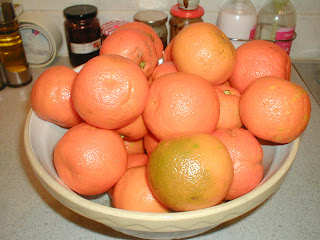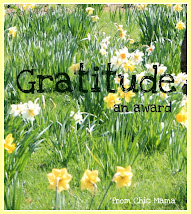
This is one of my favourites and a real party treat. It is easy to make though you have to be diligent with stirring the custard, and it knocks the socks off the shop bought powder which is rubbish. (Unlike Bird's Custard which is great and as good as real egg custard for nostalgic comfort food!)
I have this recipe in an old autograph book I got for my 18th Birthday from my best friend Anne, and while I never used it for its intended purpose it has been all over the world with me.
It also contains recipes as diverse as cooked play-dough, Anzac Cookies and Papaya Jam added at various stages, reflecting our location and the kids life stages! The kids also added some of their own recipes, which make for interesting reading!
I have no idea where this recipe originated but I know I first made it in when we lived in Mishamo, a refugee settlement in Rukwa Region in Western Tanzania in the early 80s. We had lots of lemons for lemonade and pie, and when we lived in Iringa it became a much requested party dish, and looked impressively complicated to garner lots of compliments! It's now a signature dessert and party favourite of mine.
Lemon Meringue Pie Ingredients/MethodShortcrust pastry base:
Ingredients/MethodShortcrust pastry base:8oz/200gm flour
4oz/100gm butter
1oz/25gm icing or caster or normal sugar
1 egg (for rich pastry) or water for plainer)
Method: (Preheat Oven to 200 degrees centigrade)1. Rub in butter to flour to crumbly texture
2. Add sugar and egg/water and mix well with knife blade to bind stiffly together
3. Knead lightly and roll out on floured surface
4. Put in base of 10 inch/28cm deep pie dish
5. Bake blind with dried kidney beans on greaseproof paper to weigh down for 15-20 mins
6. Remove beans and paper and bake for about 10 minutes till golden
Lemon Custard Filling:2oz/50gm flour3 tablespoons cornflour
6oz/150gm sugar
1.5 pints/850mls water
3 egg yolks - beaten - (keep whites separate for topping)
8 tablespoons lemon juice (squeezed freshly)
Lemon peel grated
pinch salt
1oz/25gm butter
Method:1. Blend Cornflour in some of the cold water (few spoonfuls) and add flour and sugar.
2. Add water and stir constantly until bubbling - remove from heat now
3. Add some of the mixture to the egg yolks, stir and return to pan and cook over low heat until bubbling again.
4. Remove from heat, add lemon juice and peel, salt and butter, stirring well to ensure not lumpy 5. Pour into baked pastry shell, cool
Meringue Topping: (I use same as Pavlova recipe - slightly crumbly and yummy!)3 Egg whites
6oz/150gm sugar
half teaspoon Vanilla Essence (or Vanilla Sugar if you keep a pod in a jar topped up with sugar)
half teaspoon Cornflour
half teaspoon vinegar or lemon juice
Method:1. Beat egg whites (electric whisk) till stiff, add remaining ingredients and beat well till peaking. 2. Top Pie with meringue, making sure to cover custard fully to edge of pie crust
3. Bake at 150 degrees Centigrade for 15 mins approx until peaks are golden.
Cool, and enjoy with a dollop of whipped cream to really indulge!
 This is a link to a fellow blogger who posts as Gracious Hospitality and has a fun draw on for January as a Tea Month (first I knew of it!) She asks that we post links to her post on our blogs. So here goes - the post link is below. I hope you visit her her page and share the lovely photos she has posted of tea gardens in Sri Lanks and Indonesia. I already wrote about tea gardens in Sri Lanka in my post on a nice cup of tea, so it is good to see these lovely scenes.
This is a link to a fellow blogger who posts as Gracious Hospitality and has a fun draw on for January as a Tea Month (first I knew of it!) She asks that we post links to her post on our blogs. So here goes - the post link is below. I hope you visit her her page and share the lovely photos she has posted of tea gardens in Sri Lanks and Indonesia. I already wrote about tea gardens in Sri Lanka in my post on a nice cup of tea, so it is good to see these lovely scenes.








 For the past few years I have bought about 5 kilos of Seville oranges each January, and made a batch to last the year. This gives enough for our own family as there are not too many marmalade or jam lovers in the house. Peanut butter and honey are preferred by our boys, which leaves me redundant on both counts in Ireland at any rate, although in Africa we became dab hands at homemade peanut butter. A real case of neccessity being the mother of invention, we had tons of wonderful local peanuts or groundnuts from the market and growing in our own shamba (garden), and we made peanut butter from roasted and shelled nuts, with the skins left on or winnowed off, both were good. We made the butter either by the labour intensive pestle and mortar grinding method, or the slightly higher tech method of the home food processor mincing attachment. The latter depended on electricity and if there was low power it was often inadequate; the joys of generator electricity are many - put on the oven or switch on an appliance and all the lights in the house dimmed!
For the past few years I have bought about 5 kilos of Seville oranges each January, and made a batch to last the year. This gives enough for our own family as there are not too many marmalade or jam lovers in the house. Peanut butter and honey are preferred by our boys, which leaves me redundant on both counts in Ireland at any rate, although in Africa we became dab hands at homemade peanut butter. A real case of neccessity being the mother of invention, we had tons of wonderful local peanuts or groundnuts from the market and growing in our own shamba (garden), and we made peanut butter from roasted and shelled nuts, with the skins left on or winnowed off, both were good. We made the butter either by the labour intensive pestle and mortar grinding method, or the slightly higher tech method of the home food processor mincing attachment. The latter depended on electricity and if there was low power it was often inadequate; the joys of generator electricity are many - put on the oven or switch on an appliance and all the lights in the house dimmed! 4lbs/1.8kgs Seville oranges
4lbs/1.8kgs Seville oranges




















 Apple Tart with Cream
Apple Tart with Cream
.jpg)


































